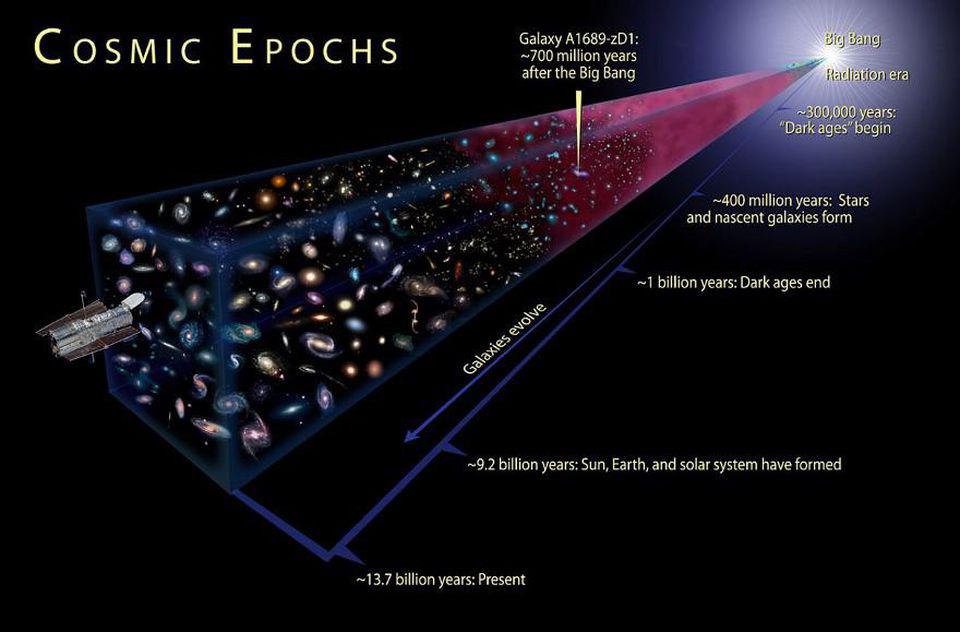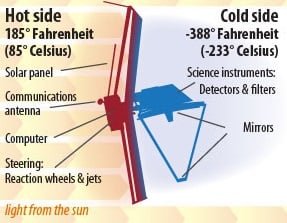Human beings have always been explorers, driven by curiosity to seek answers to the origins of life and the Universe. Our endeavors have led to numerous space missions but none as bold and revolutionary as James Webb Space Telescope (JWST in short). JWST will attempt to study the evolution of stars and formation of galaxies right after the Big Bang - in a sense it is a Time Machine looking back into a 13.7 billion year past (Figure 1) using the most sensitive infrared optics and detectors ever designed. [Hubble looks at visible and UV spectrum. Why IR ? Expansion of the Universe after the Big Bang has stretched and Doppler shifted the wavelength of the initial emitted light into the IR spectrum].
 Figure 1. The Big Bang and Cosmic Calendar. (source - www. forbes.com)
Figure 1. The Big Bang and Cosmic Calendar. (source - www. forbes.com)
The IR signals that have travelled for 13.7 billion years to reach JWST are extremely faint and require a resolution of 0.1 arc second which is equivalent to detecting a pulse of flashlight on the moon from the earth. This mission critical resolution has driven numerous engineering marvels such as gigantic kite-shaped sunshields, segmented mirrors and cryo-coolers all designed to minimize thermal and electronic noise (Figure 2). Let us deep dive into the engineering and material systems on JWST.
 Figure 2. Components of JWST (source -https://webbtelescope.org)
Figure 2. Components of JWST (source -https://webbtelescope.org)
JWST will not be in orbit around the Earth, like the Hubble is, it will orbit the Sun, 1.5 million kilometers away from the Earth at what is called the second Lagrange point or L2. This special location allows the the telescope to point its mirrors towards the Cosmos while its sunshields always face the Sun, Earth and Moon to protect from light and heat as it revolves around the Sun (Figure 3)
 Figure 3. JWST at L2 orbit. (source - https://webbtelescope.org)
Figure 3. JWST at L2 orbit. (source - https://webbtelescope.org)
Why does JWST have tennis courts size sunshields ?
The five layer gigantic sunshades allow the telescopes ultra-sensitive detectors to operate at - 230 ºC on the cold side even when sun facing side is at 100 ºC (Figure 4). The gaps between the layers with the unique kite shaped design lead to multiple internal reflections that radiate out the heat into space from the edges (Figure 2)

Figure 4. The two sides of JWST, hot and cold side. (source - https://webb.nasa.gov)
All this is achieved through clever engineering and materials selection. The sunshield is made of a lightweight material with special thermal properties, called Kapton, which is also coated with aluminum and doped-silicon to increase its emissivity. (Note - Kapton is a polyimide film that has high heat-resistance and remains stable across a wide range of temperatures from - 269 ºC to +400 ºC). Each layer of the sunshield is incredibly thin from 25 to 50 microns with special features (stiffeners, corrugations) that help to fold the layers into the Ariane 5 launch module and ensure no wrinkles when it is deployed in space.
Why does JWST have a segmented mirror, different from Hubble ?
JWST's primary mirror is thrice as big as Hubble with a diameter of 6.5 m and cross-section large enough to capture the faintest signals after the Big Bang. At the same time, it is segmented and foldable to allow transport by Ariane 5 launch module. Each of the 18 hexagon segments is supported by the most precise positioning motors and actuators capable to tilting each segment to get the exact final curvature of an ideal concave mirror and one single focal point (Note - all 18 mirrors will form a single mirror-like plane to an accuracy of 20 nanometers). (Figure 5).

Figure 5. Single focal point for 18 mirror segments (source - https://webb.nasa.gov)
Each segment is made from lightweight beryllium offering high specific stiffness. The mirrors are coated with gold (an excellent reflector for IR radiation) and encapsulated with thin top coat of amorphous silicon dioxide (for environment protection).
What lubricants were used in JWST ?
Mechanical systems, latch mechanisms and actuators use ball bearings to deploy booms for the kite-like sunshield and the most precise positioning of the 18 mirror segments. Dry film lubricant coating, MoS2, has been used to provide excellent lubricity under high vacuum, near absolute-zero temperatures with no oxygen and humidity to inhibit the sliding of the weakly bonded basal planes,.
Why does JWST cost 10 billion USD ?
Located at L2 point, JWST cannot be serviced like Hubble that was Earth orbiting. JWST has been designed and engineered to not fail - by building and testing every single piece a million ways for more than a decade. For the 6-sigma geeks (3.4 failures per million opportunities), JWST has tested to have none or from a quality perspective ~ 8-sigma (i.e., 1 defect in a trillion)
JSWT has already accomplished several tasks such as deploying the 5-layer sail, unfolding of the segmented mirrors and fly-by to L2 to finally settle down in its new home. What we can hope for from JWST in the days to come are answers to the questions that haven't even been asked yet as no one knows what the Cosmos was like after the Big Bang. Till then JWST will just sit and watch...
References
1. https://webbtelescope.org
2. https://webb.nasa.gov
3. https://www.forbes.com/sites/startswithabang/2021/06/07/5-scientific-revolutions-that-nasas-james-webb-space-telescope-will-deliver/?sh=49a4fbf82abd
USA: +1 (847) 737-1590
India: +91 (80) 4080-5555
Netherlands: +31 (85) 065 74 10